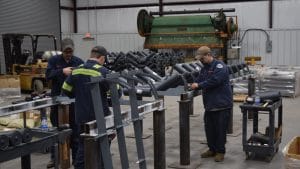The Problem With Misaligned Conveyor Idlers

While inspecting or repairing conveyor idlers you might notice the roller surfaces have become shiny. This happens when there’s a slip between belt and roller and it’s a sign the rollers are misaligned.
Even a small degree of misalignment increases belt load and leads to higher power consumption at the drive motor. It can also result in the belt mistracking and wearing faster, spilling material, or both. Each conveyor idler is aligned during installation, but impacts to the structure, excessive carryback, or hasty bearing replacement can put it out. That’s potentially very expensive.
CONVEYOR IDLER BASICS
Before diving into the details of alignment here’s a refresher on conveyor idlers. The idler’s job is to support the belt and on the carrying side, take the weight of the load. For troughed belts, the carrying idlers also provide the shape.
On the return side, the belt is flat and unloaded. This means return idlers don’t experience the same loads as those on the top side.
For a troughed conveyor belt the idlers come in sets of three rollers. The center horizontal roller takes most of the load. The rollers at each side lift the belt up to form the trough that increases carrying capacity. The type of material being carried dictates the angle of these side rollers: most are set at 35° but they may be steeper or shallower.
To help ensure good tracking, some idler sets may be fitted with additional guide rollers. These work by riding on both edges of the belt, so stopping it from moving left or right.
CONVEYOR IDLER ALIGNMENT
To avoid slip the axis of the rollers must be perpendicular to the belt centerline. If a roller is misaligned the belt will slip and rub on the roller.
Misalignment can occur in any of the three axes. In extreme cases, all three will be out simultaneously. The alignments are referred to as:
- Vertical
- Lateral
- Angular
VERTICAL MISALIGNMENT
This is when one side of the idler set is higher than the other. This can push the belt sideways, which risks material spills. Where there are guide rollers the higher side of the belt is going to push against these and will probably wear faster. However, with this kind of misalignment, there’s minimal slip between belt and roller.
LATERAL MISALIGNMENT
Lateral misalignment is when the center of the conveyor idler is offset from the center of the belt. As with vertical misalignment, it can lead to a side-to-side height difference in the belt, and guide rollers will accelerate belt edge wear. If a series of conveyor idlers have a lateral offset it may lead to tracking problems too.
ANGULAR MISALIGNMENT
This is the most expensive in terms of increasing the load on the drive motor. This is where the conveyor idler axis is not quite at 90° to the direction of belt motion. It results in the belt slipping against the roller, which causes a polished appearance that indicates a problem.
IMPACTS OF CONVEYOR IDLER MISALIGNMENT
All misalignment can cause tracking problems and increase belt wear. In the case of vertical and lateral misalignment though, the misalignment needs to be several degrees and over multiple idlers to cause significant problems.
Angular misalignment is a different matter. The problem here is that a single idler misaligned by a small amount causes friction that increases motor load. If just one or two idlers on a long conveyor are out of alignment the effect is small. However, in a long run with thousands of idlers, having even just a low percentage misaligned increases energy consumption significantly.
CAUSES OF IDLER MISALIGNMENT
The first cause of conveyor idler misalignment is if the structure suffers an impact. In cramped underground conditions, this isn’t uncommon and might not even be noticed. However, it can change the angular alignment of a series of idlers and increase the motor load.
The second cause is if the conveyor idler set is removed. The most likely reason for this is to replace a bearing or bearings. Unless great care is taken to mark how the assembly mounts to the frame, it’s almost inevitable it will go back slightly out of position.
Third, excess carryback on the belt can damage or move return idlers.
MEASURING AND CORRECTING IDLER MISALIGNMENT
When a conveyor is in service it’s very difficult to get an idler roller positioned perfectly. The key is to orient it relative to the belt edges and not to the structure (which may not be aligned with the belt.) With troughing idlers, focus on the center, load-carrying roller rather than those on the sides, even though this is the hardest to position.
Over the years conveyor specialists have developed equipment for measuring misalignment. This may have some value, but a better approach is to contact a conveyor equipment manufacturer like West River Conveyors and get assistance.
If not addressed, misalignment of conveyor idlers can become very costly. The biggest issue is the increased energy consumption of the drive motor. Other factors are faster belt wear and higher loads on the gearbox/reducer. Inevitably, these will lead to a need for maintenance sooner than would otherwise be the case. For more tips on extending belt life, click below.

